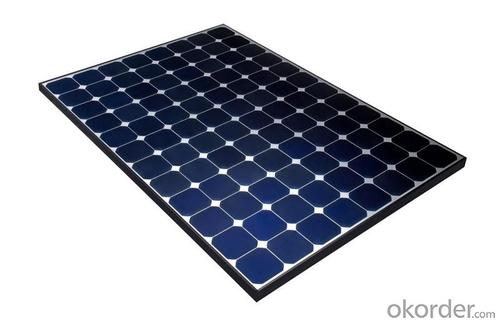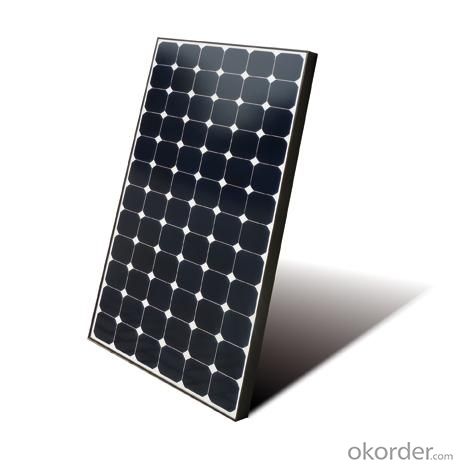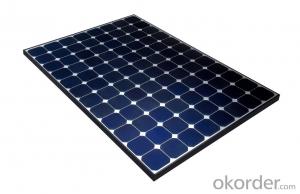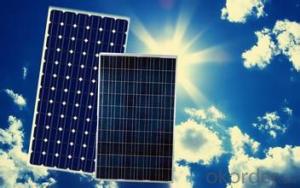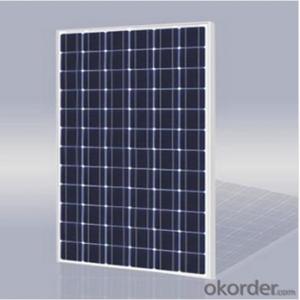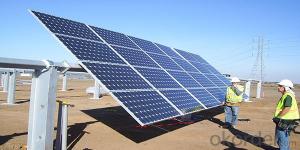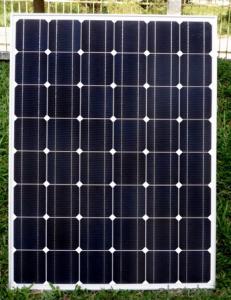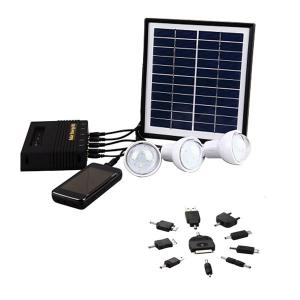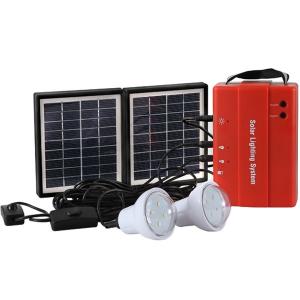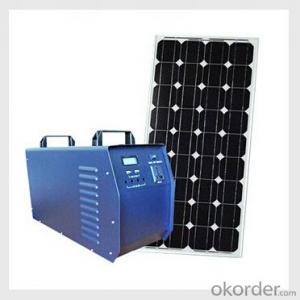180kw CNBM Monocrystalline Silicon Solar Energy Systems Tesla Panel for Home Use
- Loading Port:
- Tianjin
- Payment Terms:
- TT OR LC
- Min Order Qty:
- 100 watt
- Supply Capability:
- 1000 watt/month
OKorder Service Pledge
OKorder Financial Service
You Might Also Like
Specification
180KW CNBM Monocrystalline Silicon Panel for Home Using
Production description
Off-the-grid homes are autonomous; they do not rely on municipal water supply, sewer, natural gas, electrical power grid, or similar utility services. A true off-grid house is able to operate completely independently of all traditional public utility services. The idea has been recently popularized by certain celebrities including Ed Begley, Jr.[1] who stars in Living with Ed[2] television show on the Home & Garden Television (HGTV) network. Actress Daryl Hannahpromotes off-grid living and constructed her home in Colorado according to those principles, as does survival expert and Dual Survival co-star Cody Lundin,[3]who lives in a self-designed, passive solar earth house in the high-desert wilderness of Northern Arizona, collecting rainwater, composting waste, and paying nothing for utilities.[4][5]
The large magnitude of solar energy available makes it a highly appealing source of electricity. The United Nations Development Programme in its 2000 World Energy Assessment found that the annual potential of solar energy was 1,575–49,387 exajoules (EJ). This is several times larger than the total world energy consumption, which was 559.8 EJ in 2012.
A photovoltaic (in short PV) module is a packaged, connected assembly of typically 6×10 solar cells. Solar Photovoltaic panels constitute the solar array of a photovoltaic system that generates and supplies solar electricityin commercial and residential applications. Each module is rated by its DC output power under standard test conditions, and typically ranges from 100 to 365 watts. The efficiency of a module determines the area of a module given the same rated output – an 8% efficient 230 watt module will have twice the area of a 16% efficient 230 watt module. There are a few solar panels available that are exceeding 19% efficiency. A single solar module can produce only a limited amount of power; most installations contain multiple modules. A photovoltaic system typically includes a panel or an array of solar modules, a solar inverter, and sometimes a battery and/or solar tracker and interconnection wiring.Mennonite communities.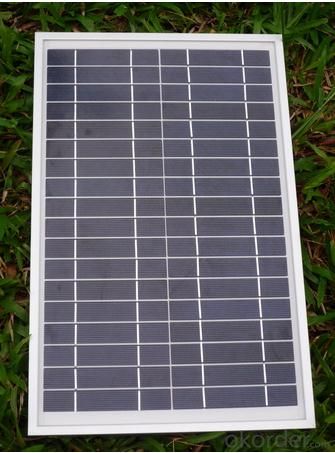
Feature
1.High conversion efficiencies resulting in superior power output performance.
2.Outstanding power output even in low light or high temperature conditions
3.Optimized design for ease of soldering and lamination
Physical characteristic
1. Rigorous quality control meets the highest international standards.
2. High-transmissivity low-iron tempered glass, strong aluminium frame.
3. Using UV-resistant silicon.
4. IS09001/14001/CE/TUV/UL
Packaging
26pcs in one carton 6pallets in 20foot container 14pallets in 40 foot container.
- Q: Can solar energy systems be used in powering music studios or recording studios?
- Yes, solar energy systems can definitely be used to power music studios or recording studios. Solar power systems are a clean and renewable energy source that can provide a reliable and cost-effective solution for powering various electrical equipment, including the high energy-consuming equipment found in music studios. Solar panels can be installed on the roof or any other suitable area of the studio building to harness sunlight and convert it into electricity. This electricity can then be used to power a wide range of equipment such as amplifiers, mixers, microphones, computers, lighting, and air conditioning systems. The size of the solar power system required will depend on the energy needs of the studio. By analyzing the energy consumption patterns and demands of the studio, solar energy experts can design and install a customized solar power system to meet the specific requirements of the studio. One of the advantages of using solar energy in music studios is the potential for significant cost savings. Traditional electricity sources, especially in commercial settings, can be quite expensive. By generating their own electricity through solar power, studios can reduce their reliance on the grid and potentially lower their electricity bills. Additionally, solar energy is a sustainable and environmentally friendly option. Music studios often consume a large amount of electricity, and using solar power can help reduce their carbon footprint and contribute to a greener future. It is worth noting that solar energy systems can also be combined with battery storage systems. This allows music studios to store excess energy produced during the day and use it during times of low solar generation or at night. This further enhances the reliability and independence of the solar power system. In conclusion, solar energy systems can be effectively used to power music studios or recording studios. They offer a clean, renewable, and cost-effective solution that can meet the energy demands of these facilities while reducing their environmental impact.
- Q: Are there any risks of electrical short circuits with solar energy systems?
- Solar energy systems, like any other electrical system, have the potential for electrical short circuits. When there is an unintended path of low resistance, a short circuit occurs and allows a large amount of current to flow. This can be caused by faulty wiring, damaged components, or improper installation. Short circuits can lead to overheating, electrical fires, or system damage. The excessive current flow can melt wires, burn insulation, and even harm the solar panels themselves. In extreme cases, short circuits can cause explosions or other dangerous situations. To reduce the risks of short circuits, it is crucial to have qualified professionals install the system according to safety guidelines and local codes. Regular maintenance and inspections are also important for identifying and addressing potential issues. Installing a circuit breaker or fuse within the system can automatically disconnect the circuit in case of a short circuit. Using high-quality components and wiring specifically designed for solar energy systems can also help minimize the risks of short circuits. It is important to follow the manufacturer's instructions and guidelines for system maintenance and operation. In conclusion, although there are risks of electrical short circuits with solar energy systems, these risks can be effectively managed and minimized through proper installation, regular maintenance, and adherence to safety guidelines.
- Q: How do solar energy systems contribute to job creation?
- Solar energy systems contribute to job creation in several ways. Firstly, the installation and maintenance of solar panels require skilled labor, creating job opportunities for electricians, engineers, and technicians. Additionally, the manufacturing of solar panels and related equipment also generates employment in the renewable energy industry. Moreover, as solar energy becomes more popular and widespread, there is a growing need for sales, marketing, and customer service personnel to promote and support solar energy systems. Overall, the adoption of solar energy systems creates a ripple effect, stimulating economic growth and providing employment opportunities across various sectors.
- Q: What are the different applications of solar energy systems in transportation?
- Solar energy systems can be applied in various ways in transportation to reduce carbon emissions and dependence on fossil fuels. One application is in electric vehicles (EVs), where solar panels can be installed on the roof or hood of the vehicle to harness solar energy and charge the batteries. This can extend the range of EVs and reduce the need for charging from the electrical grid. Solar energy can also be used in charging stations for EVs. These charging stations can be equipped with solar panels to generate electricity and provide clean energy for charging EVs. This reduces the reliance on non-renewable energy sources and contributes to a more sustainable transportation system. Another application of solar energy systems in transportation is in public transportation. Solar-powered buses and trains can be used to provide emissions-free transportation options, reducing air pollution and improving air quality in cities. Solar panels on the roofs of these vehicles can provide power for various onboard systems such as lighting, air conditioning, and information displays, further reducing energy consumption. In addition to EVs and public transportation, solar energy systems can also be used in other modes of transportation such as bicycles and boats. Solar panels can be integrated into the design of these vehicles to generate electricity for powering electric motors or charging batteries, making them more energy-efficient and environmentally friendly. Overall, the applications of solar energy systems in transportation are diverse and offer significant potential for reducing greenhouse gas emissions and promoting sustainable transportation options. By harnessing the power of the sun, we can create a cleaner and greener future for transportation.
- Q: What is the impact of temperature on the performance of solar panels?
- The impact of temperature on the performance of solar panels is primarily negative, although there are some factors that can mitigate the effects. Generally, as the temperature increases, the efficiency of solar panels decreases. This is because the semiconductors within the panels become less effective at converting sunlight into electricity as they heat up. One of the main reasons for this decrease in efficiency is the relationship between temperature and the voltage output of solar panels. With increasing temperature, the voltage output decreases, leading to a reduction in the power output. This is known as the temperature coefficient of the solar panel, and it varies depending on the type and quality of the panel. Additionally, increased temperature can cause thermal expansion and contraction, which can lead to stress on the electrical connections and components within the panel. This can result in the degradation of the panel's performance over time. However, it is important to note that not all aspects of solar panel performance are negatively affected by temperature. In fact, higher temperatures can increase the conductivity of the electrical connections, which may improve the panel's overall performance. Furthermore, some solar panels are designed with cooling mechanisms, such as air or water circulation, to maintain their temperature and mitigate the negative effects. In conclusion, the impact of temperature on the performance of solar panels is predominantly negative, leading to a decrease in efficiency and power output. However, with proper design and cooling mechanisms, the effects can be mitigated to some extent, allowing solar panels to continue generating electricity even in high-temperature environments.
- Q: Can solar energy systems be used in camping or outdoor activities?
- Yes, solar energy systems can definitely be used in camping or outdoor activities. In fact, solar power is a great solution for off-grid living or when you're away from traditional power sources. Portable solar panels, also known as solar chargers, can be used to harness the sun's energy and convert it into electricity to power various camping or outdoor devices. There are several advantages of using solar energy systems for camping. Firstly, they provide a renewable and sustainable source of power, reducing your reliance on fossil fuels or disposable batteries. This not only helps to protect the environment but also saves you money in the long run. Solar energy systems can be used to charge a wide range of devices, such as smartphones, tablets, laptops, cameras, portable speakers, and even small appliances like coolers or lights. This ensures that you can stay connected, capture memories, or simply enhance your camping experience without worrying about battery life. Portable solar panels are lightweight, compact, and easy to carry, making them ideal for camping or outdoor activities. They can be set up in various ways, including attaching them to a backpack, placing them on the ground, or mounting them on a tent or RV. Some solar chargers also come with integrated batteries, allowing you to store energy for later use, ensuring a constant power supply even during cloudy days or at night. It is worth mentioning that the efficiency and power output of solar energy systems can vary depending on factors like weather conditions, panel quality, and the angle at which they are positioned towards the sun. Therefore, it's important to choose reliable and reputable solar products that suit your specific needs. Overall, solar energy systems are a fantastic option for camping or outdoor activities, providing a clean, reliable, and sustainable source of power. Whether you want to charge your devices, light up your campsite, or power small appliances, solar power can greatly enhance your outdoor experience.
- Q: How do solar energy systems contribute to reducing the risk of power outages during extreme weather events?
- Solar energy systems contribute to reducing the risk of power outages during extreme weather events by providing a decentralized and reliable source of power. Unlike traditional power grids that rely on centralized power plants, solar energy systems generate electricity locally and are less susceptible to damage caused by severe weather. By diversifying the energy mix and incorporating solar power into the grid, communities can maintain a steady power supply even in the face of power disruptions caused by extreme weather events.
- Q: How efficient are solar energy systems?
- Solar energy systems are highly efficient as they convert sunlight directly into electricity or heat without any moving parts. With advancements in technology, solar panels can now convert up to 20% of sunlight into usable energy, making them a reliable and sustainable source of power. Additionally, solar energy systems have a long lifespan and require minimal maintenance, further enhancing their efficiency.
- Q: What is the role of solar energy in achieving energy independence?
- Solar energy plays a crucial role in achieving energy independence by providing a clean, renewable, and abundant source of power. It reduces our dependence on fossil fuels, mitigates climate change, and promotes sustainability. Solar power empowers individuals, communities, and even entire nations to generate their own electricity, reducing reliance on imported energy and creating a more resilient and self-sufficient energy system.
- Q: Can solar energy systems be used in commercial or industrial applications?
- Yes, solar energy systems can definitely be used in commercial or industrial applications. In fact, many businesses and industries around the world are increasingly adopting solar energy systems to power their operations. These systems can be installed on rooftops, parking lots, or ground-mounted, providing a reliable and sustainable source of electricity. Not only does solar energy help businesses reduce their carbon footprint and lower their energy costs, but it also provides them with long-term energy independence and resilience.
Send your message to us
180kw CNBM Monocrystalline Silicon Solar Energy Systems Tesla Panel for Home Use
- Loading Port:
- Tianjin
- Payment Terms:
- TT OR LC
- Min Order Qty:
- 100 watt
- Supply Capability:
- 1000 watt/month
OKorder Service Pledge
OKorder Financial Service
Similar products
Hot products
Hot Searches
Related keywords



